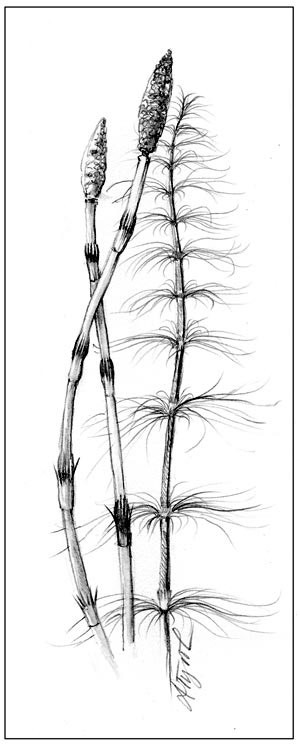
Three hundred million years ago, dinosaurs roamed the land. The earth they inhabited was hot and humid and covered in vast, swampy forests that today would seem most bizarre.
Some of the plants resembled giant bottle brushes, growing 60 feet tall. Others sported 100-foot-tall trunks that were clothed in overlapping scale-like leaves. Notably absent were flowers: It would be another 200 million years before flowering plants evolved (approximately 125 million years ago.)
Although the dinosaurs are long departed, victims of a distant natural catastrophe, some of the plants in their landscape stubbornly survive. They persist to this day in the form of the brush-like horsetail and scaly, creeping club mosses.
About 10 species of horsetails grow in the Northeast, and they can be found in wet soils or semi-aquatic areas. The plant has hollow jointed stems, and some species have thread-like side-branches that are commonly mistaken for leaves. But the leaves of these horsetails are tiny, so they rely on green side branches and a green main stem for photosynthesis.
Horsetails appear almost unchanged from the earliest plants that made the transition from water to land some 400 million years ago. Lacking flowers, a horsetail reproduces by spores from a cone that grows at the tip of its stem. The spores bear long, ribbon-like extensions that allow them to be dispersed by air current. If they land in a damp place, they grow into an ‘alternate generation’ of tiny plants, known as prothalli, which can be either male or female. Male prothalli produce sperm that, when washed off the plant by rain, float to find and fertilize the eggs in nearby female prothalli. Once fertilized, eggs grow into regular horsetail plants.
As horsetails began evolving, they had to develop a means to stand upright without the support of water. The answer was to reinforce their hollow stems with silica, which is also the chief component of sand. Today’s horsetails have a scratchy texture due to their high silica content. Centuries ago, we humans began using this abrasive to our advantage to scour pots and put fine, smooth finishes on pewter and silverware. Nowadays, horsetail silica, finer than any silica powder devised by man, is used to polish certain medical and dental products.
While horsetails can flourish in various locations, including sites that are quite dry, club mosses are more restricted, growing mostly in the cool, shaded environment of boreal forests. Club mosses are low plants with creeping, branched stems that hug the ground. Since they resemble miniature evergreen branches, they are commonly known as ground cedar, ground pine or princess pine. When these plants were in their heyday 300 million years ago, during the Carboniferous Period, an estimated 50 percent of the world’s vegetation consisted of giant club mosses. Today their fossil remains make up coal deposits with enormous economic value.
Today’s club mosses, tiny in comparison to their towering ancestors, have modern-day economic value. In some areas some species are harvested in huge amounts to make Christmas wreaths.
(Recently two buyers in Wisconsin and Michigan collected more than 170,000 pounds of club mosses in a single season, prompting concern among some scientists that extensive harvesting of the plant in certain areas might endanger its existence in those spots – especially since it takes up to 20 years for club mosses to complete their reproductive cycle.)
Like horsetails, club mosses reproduce via spores rather than flowers and seeds. The spores are shed from the club-shaped, yellowish cones that arise from their tips. Although each spore is microscopic, being only one-fortieth of a millimeter across, masses of them are collected for various uses. The spores, also known as “vegetable sulfur,” have high oil content, which means they are extremely flammable when airborne. Early photographers ignited the spores for flash photography, and the spores are still sold today for magic tricks and other theatrical special effects. Club moss spores also are used as tracers in certain types of scientific research and as an ingredient in some medicines and cosmetics.
Although horsetails and club mosses are considered evolutionary ‘relics,’ they are easy to spot in the northern forest. And unlike many inorganic relics, these humble, spore-bearing plants have modern-day utility.

